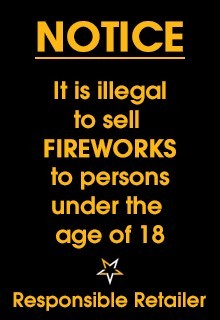Categories
- Buy 2, Get 1 FREE Deals
- Fireworks Display Packages
- Single Ignition Display Units
- Compound Cake Display Units
- Selection Boxes
- Rocket Packs
- Barrage Packs
- Roman Candle Cakes
- Roman Candles & Shot Tubes
- Fountains and Mines
- Catherine Wheels
- Sparklers
- Firecrackers
- Fireworks Accessories
- Gender Reveal
- Indoor Fireworks
- Glow Products
- Confetti Party Cannons
- Chinese Sky Lanterns
- Smoke Fountains & Flares
- Remote Firing Systems
- Discontinued Products
- Last Minute Central London Collections
History of Fireworks
Fireworks are a class of explosive pyrotechnic, which are most often used for artistic and visual effects. Culture and religious purposes also contribute to the use of pyrotechnics, but most often than not, fireworks are used as part of a fireworks display. A fireworks event (also referred to as a fireworks display or pyrotechnic show) is a display of the effects produced by firework devices.
Fireworks displays are common throughout the world and are the focal point of many cultural and religious celebrations. The earliest documentation of fireworks dates back to 7th Century China, where they were invented. They were used to accompany many festivities and then eventually spread to other cultures and societies around the world. Important events and festivities such as the Spring Festival (Chinese New Year) and the Mid-Autumn Festival are times when fireworks are guaranteed to be seen. China is the largest manufacturer and exporter of fireworks in the world.
Fireworks within the United Kingdom is very popular during the end of each year. Guy Fawkes Night which is held annually in November, celebrates the prevention of the notorious Gunpowder Plot of 5th November, 1605 where an attempt to blow up the houses of parliament was made.
Who Is Guy Fawkes
Guy Fawkes is one of the longest living icons in English history. His story is unique and one of the most interesting incidents to happen in the United Kingdom, which is why the story of November the 5th is still told to this day.
The story of Guy Fawkes fascinates many people and this article will walk you through this amazing tale, and how the famous gunpowder plot unfolded.
The story began when Guy Fawkes left to go to battle in the Eighty years war on the side of the Spanish Catholics against the Protestant Dutch reformers. This eventually led him to meet Thomas Wintour, with whom he returned to England.
Wintour introduced Fawkes to a man called Robert Catesby, who was planning to assassinate King James I to restore the Catholic monarch to the throne. The plotters secured the lease to a small part of the basement beneath the House of Lords, and Fawkes was placed in charge of the gunpowder they were planning to use. However, the authorities were tipped off and searched Westminster Palace during the early hours of 5 November, and found Fawkes in the basement alone guarding the explosives. He was questioned and tortured over the course of the next few days, and eventually he broke. According to Fawkes, 20 barrels of gunpowder were brought at first, followed by another 16 on 20 July. On 28 July however, the ever-present threat of the plague delayed the opening of Parliament until Tuesday, 5 November. As he was about to be executed on 31 January, Fawkes jumped from the scaffold where he was about to be hanged and broke his neck.
Guy Fawkes is firmly associated with the Gunpowder Plot and on 5 November 1605 Londoners were encouraged to celebrate the King's escape from assassination by lighting bonfires. Parliament designated November 5th as a day of thanksgiving known as "the joyful day of deliverance", and remained in force until 1859. Although he was only one of 13 conspirators, Fawkes is today the individual most recognised name associated with the failed Plot.
In Britain, November 5th has variously been called Guy Fawkes Night, Guy Fawkes Day and Bonfire Night. The latter relates directly back to the original celebration of 5 November 1605 when a bonfire was lit along with a fireworks display. Bonfires were accompanied by fireworks from the 1650s onwards, and it became the custom to burn an effigy which, contradiction to belief is usually the pope after 1673 when the heir, James Duke of York, made his conversion to Catholicism public. But in the current day and age the traditional effigy is in fact Guy Fawkes. The "guy" is normally created by children, from old clothes, newspapers, and a mask. Some Children still carry out the tradition of carrying the guy through the streets asking passers by for ‘a penny for the guy’. The money is used to buy fireworks to accompany the bonfire in which they will throw the guy that night.
Fireworks for Guy Fawkes night
This is the one night where everyone joins together to make a lot of noise, so get hold of a nice mixture of colour, noises and effects and put together a display for everyone to enjoy.
Some firework tips for you:
- Sparklers are a major crowd pleaser and they make a nice icebreaker before your display. Consider glow sticks too as a safer alternative to these.
- Include traditional items such as catherine wheels, roman candles and fountains.
- Keep a nice mix of fireworks to cater for everyone. Ground level fireworks such as fountains, medium level effects including shot cakes and barrages and of course the high effects such as rockets.
- Have a nice, colourful opening and finish by pairing up some bigger fireworks for added impact.
- A combined Halloween and Guy Fawkes party creates a great atmosphere with both fancy dress and fireworks too! But make sure you inform your neighbours so they are aware and expect the fireworks.
- Larger cakes called single ignition boxes or displays in a box units can provide a hassle free way of making close to professional effects by lighting one fuse, ideal for less experienced firers, or if you don’t have time to set a full display up.
Bonfire advice
Letting off loads of fireworks is great fun but there’s nothing like a good bonfire too!
But make sure you consider all safety aspects before starting a bonfire! Ultimately you need to decide; Do I really need to have a bonfire? Don’t be pressurised by the occasion to provide one if it is unsafe to do so. Unfortunately, fire and explosives do not mix, so you have to be extremely careful when burning a bonfire along with a fireworks display. Here are some tips to help you prepare:
- The safest option is to start your bonfire after the firework display has finished.
- If you intend to have a display while the fire is going, do not have the audience viewing point between the fire and the firework area. To be safe you should aim to have the fire at least 30-50m from the audience zone.
- It is not practical or safe to try and have a bonfire and fireworks going at the same time in the back garden.
- Never use flammable materials to light the bonfire.
- Always turn the fire over before lighting it to make sure there are no sheltering animals.
- Your local fire brigade will be very happy to give you more advice. Look for your local office and contact them for further information.
- Tell the fire brigade if you’re planning a large or public bonfire so they are aware and take a mobile phone you in case of any problems.
Remember Remember the 5th of November
The words 'Remember Remember' refer to Guy Fawkes, who on the 5th November 1605 was caught in the cellars of the Houses of Parliament with several dozen barrels of gunpowder. Guy Fawkes was later tried as a traitor, along with his co-conspirators for plotting against the government. Fawkes was sentenced to death and the form of the execution was one of the most horrific sentences to be ever practised, he was eventually hung, drawn and quartered which reflected the serious nature of the crime of treason.
The following year in 1606 it became an annual custom for the King and Parliament to commission a sermon to honour the event. Lancelot Andrewes was the first to deliver a Gunpowder Plot Sermon. This practice, along with the nursery rhyme, was enforced to ensure that this crime would never be forgotten! Hence the saying 'Remember, remember the 5th of November'
Bonfire night is a tradition held every year in the UK to celebrate the prevention of a plot to kill King James I. It was from this historical event that the poem 'remember, remember the 5th of November' originated. It is tradition to light a bonfire and throw a 'guy' made by children into the fire, to commemorate this day. A fireworks display is also put on show.
The rhymes and chants which people also participate in are another fundamental part of the celebration of Bonfire Night. In certain counties they are as integral to the custom as the burning of the Guy and the lighting of fireworks in the UK.
The most well known rhyme that is used to honour this ritual is the 'remember, remember' poem:
"Remember, remember the fifth of November
Gunpowder, treason and plot.
I see no reason, why gunpowder treason
Should ever be forgot.
Guy Fawkes, guy, t'was his intent
To blow up king and parliament.
Three score barrels were laid below
To prove old England's overthrow.
By God's mercy he was catch'd
With a darkened lantern and burning match.
So, holler boys, holler boys, let the bells ring.
Holler boys, holler boys, god save the king.
And what shall we do with him?
Burn him!"




